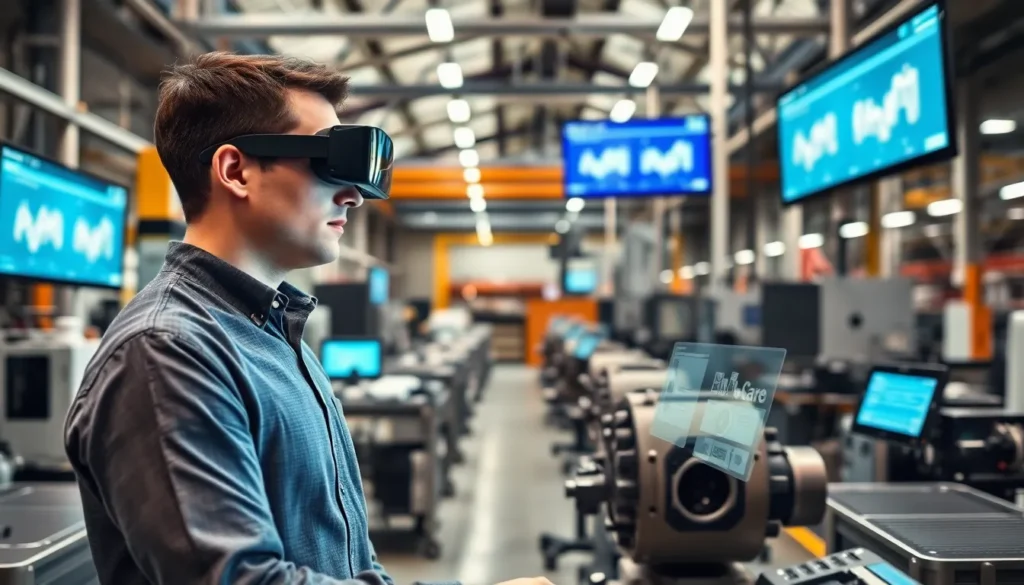Imagine walking through your favorite store, and instead of just browsing the shelves, you see helpful virtual assistants hovering alongside the aisles, showcasing the newest arrivals while sharing quirky product trivia. Welcome to the future of augmented reality (AR) where the lines between the digital and real worlds blur. As AR technology matures, it promises to reshape everything from how businesses interact with consumers to the way we socialize. Let’s jump into this fascinating domain and explore how augmented reality is poised to revolutionize our lives, and have a little fun along the way.
Table of Contents
ToggleTechnological Advancements Driving Augmented Reality

Augmented reality has seen significant strides due to advancements in various technologies. First off, the development of more powerful processors has enhanced AR capabilities, allowing real-time data processing and smoother graphics. Recently, companies have harnessed mobile devices and wearables like smart glasses to create portable AR experiences that were unfathomable a decade ago.
Besides, improvements in computer vision are allowing augmented reality systems to understand and interpret the environment better. This includes everything from recognizing objects to accurately mapping spaces. The introduction of 5G technology plays a crucial role too. It offers low latency and high-speed wireless networks, ensuring AR applications operate seamlessly, which is vital for immersive experiences.
Together, these advancements are not merely technological benchmarks: they are the building blocks for the future of augmented reality. Expect the next generation of AR applications to be more intuitive and context-aware, fundamentally changing how users engage with the world around them.
Applications of Augmented Reality Across Industries
When it comes to applications of augmented reality, the possibilities are nearly limitless. For instance, in healthcare, AR assists surgeons during procedures by overlaying critical information, reducing risks, and improving surgical precision. This isn’t just a fancy gadget: it’s a matter of life and death.
Retailers are also embracing AR, enhancing customer’s shopping experiences. Picture this: trying on virtual clothes via an app before making a purchase, effectively eliminating the hassle of returns. Brands like IKEA are already using AR to help customers visualize how furniture would look in their home.
Education is another sector ripe for AR innovation. Imagine students not just reading about the solar system, but exploring a 3D model of it in their classroom. AR transforms dull textbooks into dynamic learning experiences.
In terms of real estate, potential buyers can explore properties via AR tours, making home shopping not only more convenient but also engaging. From marketing campaigns to manufacturing processes, augmented reality’s penetration into various industries highlights its role as a transformative tool.
Impact on Consumer Experiences and Engagement
The impact of augmented reality on consumer experiences cannot be overstated. By creating immersive and interactive contexts, AR captivates users like never before. Imagine a customer walking into a clothing store and pointing their phone at a dress: suddenly, details about the fabric, care instructions, and even styling tips pop up on their screen. This kind of engagement fosters a deeper connection between the consumer and the brand.
Also, AR allows brands to tell stories in fresh and compelling ways. A simple snack can come alive with a visual narrative on its origins, ingredients, or even a recipe when users scan the packaging. This not only educates consumers but also builds brand loyalty in a saturated market.
Besides, augmented reality can be leveraged during events or conferences to immerse participants in experiences that resonate with the brand’s message, heightening engagement and building lasting memories.
Challenges and Considerations for Widespread Adoption
Even though its exciting potential, the journey toward widespread adoption of augmented reality isn’t without challenges. One major hurdle is the need for consumer education. Many individuals are still unfamiliar with AR technology, which can create hesitation when it comes to engaging with new applications.
Privacy concerns also loom large. As AR applications often require personal data to function effectively, users may hesitate to share sensitive information. Ensuring that AR solutions respect and protect user privacy will be crucial for fostering trust.
Also, a significant barrier to entry includes the cost of AR technology for both developers and consumers. Creating sophisticated AR experiences can be resource-intensive, and not all companies possess the necessary financial backing.
Finally, a significant consideration is accessibility. Ensuring that augmented reality applications can be used by everyone, including those with disabilities, is vital for a truly inclusive digital environment.
The Role of Artificial Intelligence in Augmented Reality
Artificial intelligence (AI) has a pivotal role within the realm of augmented reality. It powers the data analysis that underpins many AR functionalities, enabling applications to understand user behavior and preferences. For example, AI can learn from a user’s interactions to suggest personalized AR experiences, whether that’s highlighting items in a store based on past purchases or offering tailored virtual experiences.
Also, AI enhances object recognition capabilities. The faster AR can identify objects in the real world, the more seamless the user experience will be. Imagine navigating new cities with your AR glasses, which instantly recognize landmarks and deliver contextual information in real time.
Besides, AI can analyze user-generated data to optimize AR content continuously, ensuring that experiences are engaging, relevant, and appealing without requiring constant updates from developers.
Future Trends and Predictions for Augmented Reality
Looking ahead, several trends are shaping the future of augmented reality. One notable trend is the integration of AR with virtual reality (VR). As the lines between these two technologies continue to blur, we can anticipate hybrid experiences that combine the immersive characteristics of VR with the interactivity and practicality of AR.
Another trend is the rise of AR in social media platforms. As seen with various filters and effects, social media is driving AR’s popularity. Expect this to evolve, with brands leveraging AR integration for marketing strategies that resonate with audiences in unique ways.
Also, AR will likely see expansion in remote work settings. Imagine training sessions where employees can interact with 3D models of machinery or equipment from their homes, enhancing learning without geographical limitations.
Finally, there will be a growing emphasis on AR ethics and safety, especially as the technology becomes more embedded in daily life. Developers, stakeholders, and users will need to consider how AR impacts privacy, accessibility, and even mental well-being.





